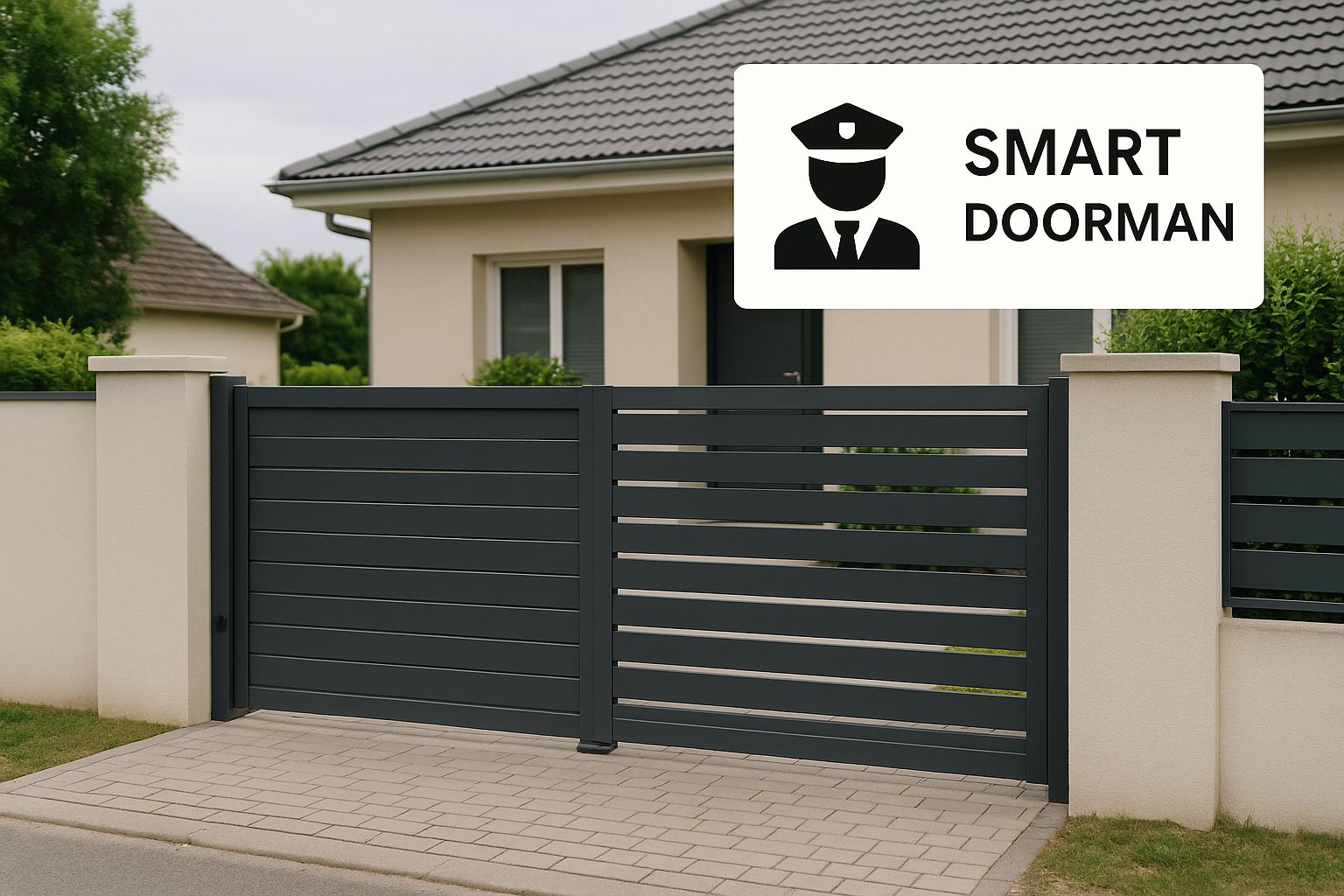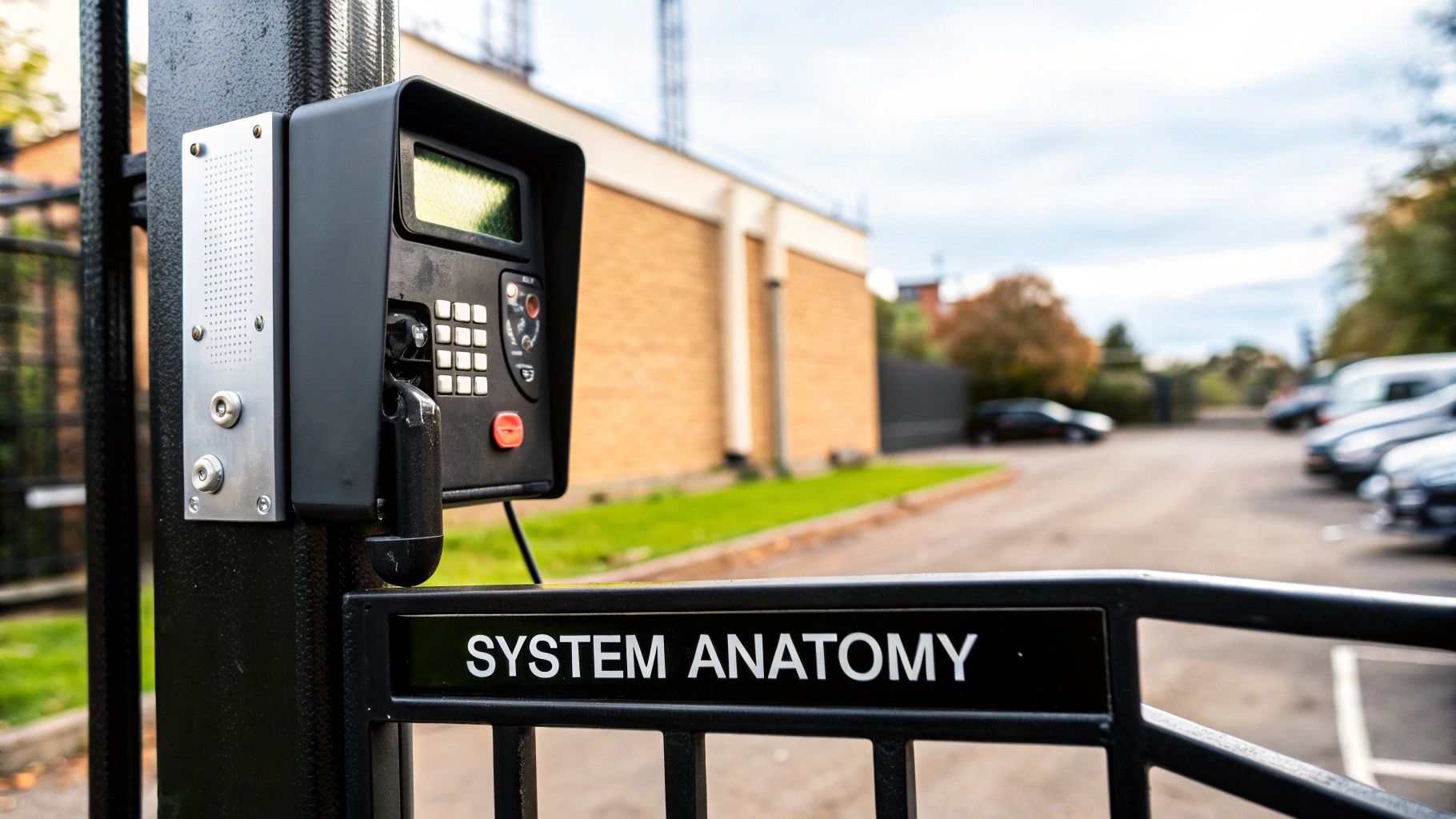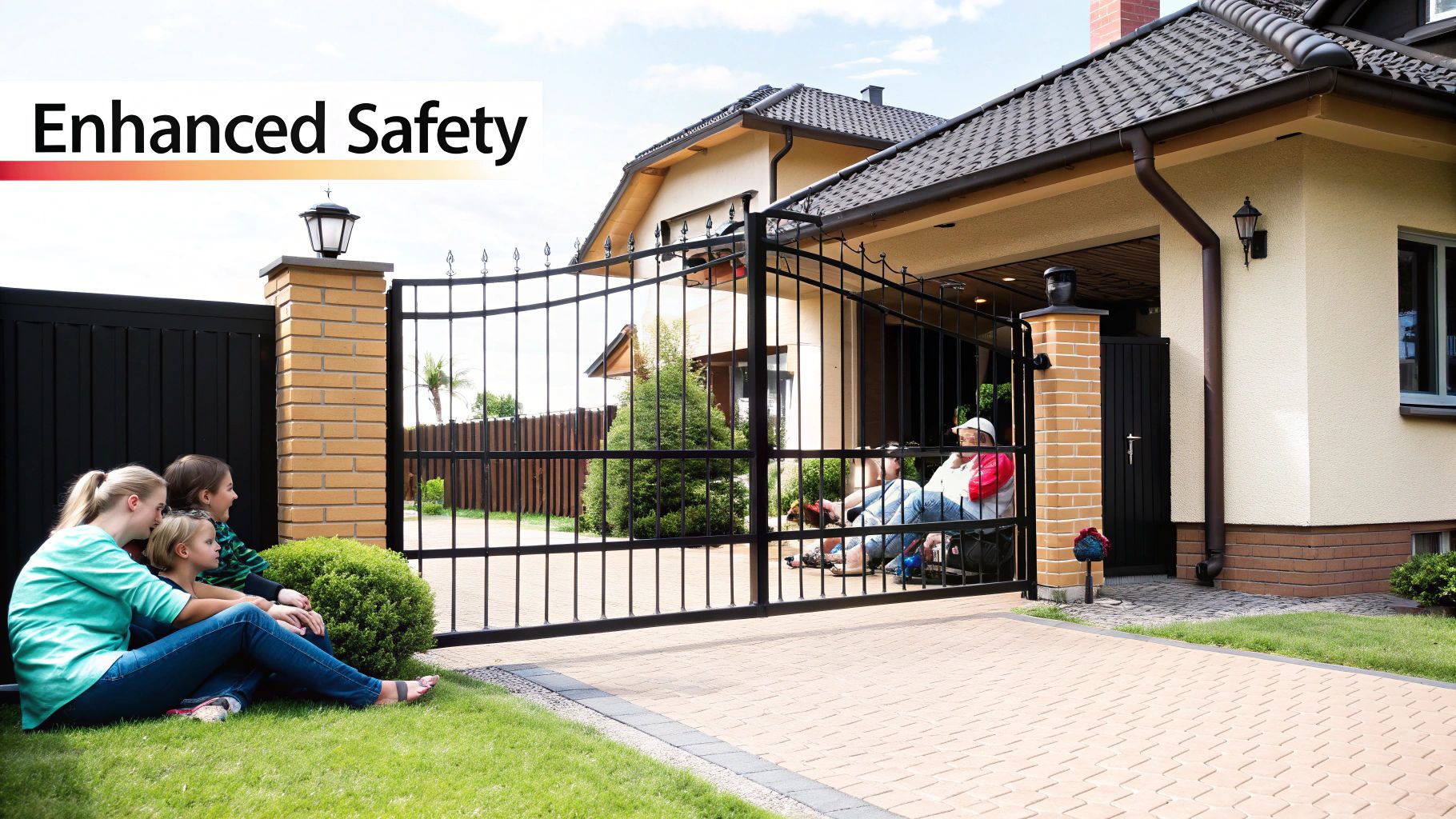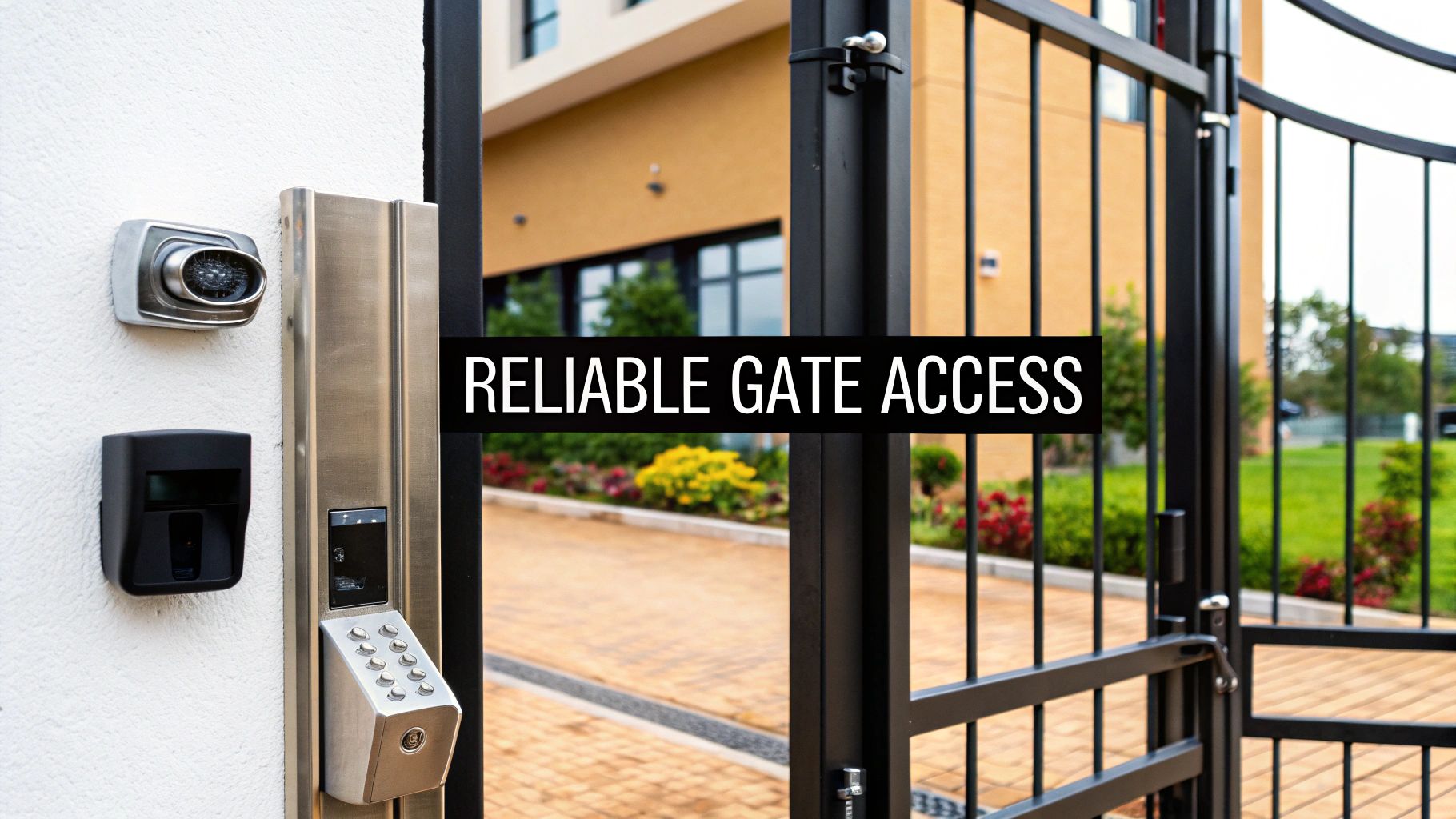A gate access system is really just a high-tech gatekeeper for your property. Think of it as the modern-day replacement for a traditional lock and key, but with a whole lot more intelligence and control packed in. Instead of just physically blocking an entrance, it's a complete security solution designed to manage who comes and goes through a gated area.
What Is a Gate Access System Anyway?
Let’s start with a simple comparison. A standard padlock on a gate does one job: it keeps it shut. That's it. It can't tell you who tried to get in, what time they were there, or let a delivery driver through for a one-time drop-off when you're not home. A gate access system, on the other hand, is the smart, ever-watchful upgrade to that basic lock. It's the entire setup that secures an entry point from start to finish.
This infographic paints a great picture of the system acting as a 'Smart Doorman' for a property.

This simple analogy really gets to the heart of it—the system automates the decision-making right at your property's front line. At its core, any gate access system, no matter how complex, performs three fundamental jobs that work together to keep your property secure.
The Three Core Functions
A gate access system isn't just one device; it's a team of components working in concert. You can break down its main responsibilities into a simple, logical sequence that ensures both security and convenience.
-
Identification: First, the system needs to figure out who is requesting entry. This could be a resident punching in a code, a visitor calling up on an intercom, or even a vehicle with an RFID tag automatically being detected as it approaches.
-
Authorization: Once the person or vehicle has been identified, the system cross-references that information with its permissions list. It's essentially asking, "Is this person on the approved list, and are they allowed in at this specific time?"
-
Access: If everything checks out and authorization is a go, the system sends a command to the gate operator. That’s the mechanism that physically swings or slides the gate open, granting access.
The real power of a gate access system is how it automates these three steps—Identify, Authorize, and Access—without needing someone standing there 24/7. It delivers both top-notch security and incredible efficiency.
This trio of functions is what turns a simple physical barrier into an intelligent, responsive checkpoint. It gives homeowners, property managers, and business owners precise control, allowing them to manage traffic flow, keep unauthorized people out, and even maintain a detailed log of everyone who comes and goes. This is the bedrock of modern property security.
How a Modern Gate Access System Works

To really get a handle on what a modern gate access system can do, it helps to pop the hood and see how all the pieces fit together. Think of it less like a single product and more like a well-oiled security team. Every member has a distinct role, but they’re all constantly communicating to achieve one thing: secure, controlled entry.
At its heart, a gate access system is designed to automate manual processes and boost productivity when it comes to who gets in and out. Let's break down the essential parts that make this possible.
Key Components of a Modern Gate Access System
To understand how these systems function, it's best to look at each individual component and its role in the bigger picture. The table below breaks down the essential parts, from the physical gate to the software that runs the show.
| Component | Primary Function | Common Examples |
|---|---|---|
| Physical Gate | The physical barrier that stops unauthorized entry. It's the "muscle" of the operation. | Sliding gates, swing gates, barrier arms, vertical lift gates |
| Gate Operator | The motor that physically opens and closes the gate after receiving a command. | Hydraulic arms, electromechanical motors, chain-drive systems |
| Access Control Device | The "brain" or input point where a user presents their credentials to request access. | Keypads, card/fob readers, biometric scanners, mobile apps |
| Control Panel | The central hub or "nervous system" that processes requests and makes the final decision. | On-premise control boxes, cloud-based management software |
| Intercom System | The "voice and ears," allowing communication with and remote entry for visitors. | Audio-only intercoms, video intercoms with mobile integration |
Each of these components plays a critical role. Without any one of them, the system's effectiveness is compromised, highlighting how they must all work in seamless coordination.
The Muscle: The Gate and Operator
First up, you have the most obvious part: the physical gate. This is the heavy lifter, the part that literally stops someone from driving or walking onto your property. It could be a sliding gate that runs along a track, a classic swinging gate, or a simple barrier arm you'd see at a parking garage.
But a gate is just a fancy fence without its gate operator. This is the motor—the electromechanical powerhouse that receives the command to open or close. The operator is what gives the gate its motion and turns it into an active part of your security setup.
The Brain: Access Control Devices
Next are the access control devices, which act as the "brain" of the system. These are the different ways a user can prove they have permission to enter.
- Keypads: The tried-and-true method where someone punches in a PIN.
- Card or Fob Readers: A quick swipe or tap of an authorized card or key fob.
- Biometric Scanners: Higher-security options that use a unique fingerprint or facial scan.
- Mobile Apps: Increasingly popular, these let people open the gate right from their smartphone.
Each of these devices takes a credential—a code, a card, a fingerprint—and translates it into a digital signal. That signal then gets passed along to the control panel for the final say-so.
The Nervous System: The Control Panel
The control panel is the true central hub connecting everything. It’s the "nervous system" that receives the signal from a keypad or card reader, instantly checks it against its list of approved users, and—if everything matches up—tells the gate operator to open.
This panel is also the command center for administrators. It's where you can add a new employee's key fob, delete an old one, or set specific access times—like letting a delivery driver in only between 9 AM and 11 AM. The demand for this level of control is a big reason why the global access control market is expected to jump from USD 3.5 billion in 2023 to USD 6.8 billion by 2032.
The control panel is the unsung hero of any gate access system. It’s what transforms a collection of hardware into an intelligent, programmable security solution that can adapt to your specific needs.
The Voice and Ears: Intercom Systems
Finally, you have the intercom—the "voice and ears" of your gate. This is absolutely essential for dealing with visitors, delivery drivers, or anyone who doesn't have a pre-approved key card or code. When a visitor presses the intercom button, they can talk directly to someone inside. For a deeper look, our guide to building a complete intercom system has plenty of great information.
This allows for a quick, real-time conversation and remote unlocking of the gate, adding a massive layer of both convenience and security. The intercom closes the loop, making sure your property is both protected from strangers and welcoming to legitimate guests.
Comparing Different Types of Gate Access Systems
Choosing a gate access system is a lot like picking the right tool for a job. You wouldn't use a small screwdriver when you need a power drill, and the same thinking applies here. What works for a quiet suburban home is worlds away from what a bustling commercial warehouse needs. Understanding the key differences is the first step toward making a smart investment.
Let's walk through the most common types of systems, breaking them down by how they actually grant access. Each one strikes a different balance between security, convenience, and cost.
Keypad and PIN Entry Systems
The classic keypad is probably the first thing that comes to mind. It’s as straightforward as it gets: someone walks or drives up, punches in a secret code (Personal Identification Number or PIN), and the gate opens. It's a technology everyone understands.
- Best For: Gated homes, small residential communities, or businesses with moderate traffic where the risk of a shared code isn't a huge concern.
- Pros: They are generally inexpensive to install and dead simple to use. No physical key or card to lose.
- Cons: The biggest weakness is the code itself. PINs can be forgotten, shared with too many people, or even spied on by someone watching from a distance.
While they’ve been a reliable workhorse for decades, many properties are moving toward options that offer better control and security.
Card and Key Fob Readers
This is a major step up from a simple PIN. Instead of a code that can be shared, users get a physical credential—a plastic card or a small key fob—that they tap or wave near a reader.
You see these everywhere, from office buildings to apartment complexes, for a good reason. They offer a much more robust way to manage who comes and goes. If an employee quits or a resident moves out, you can simply deactivate their fob in the system. Trying to change a PIN that hundreds of people know is a logistical nightmare.
The real power of a card or fob system is its ability to give you granular control. You can see exactly who entered and when, creating a detailed audit trail that a keypad simply can't provide.
Telephone and Video Intercom Systems
So, what happens when you have visitors who don't have a code or a fob? This is where intercoms come in. They allow guests to buzz a specific unit, resident, or front desk right from the gate. The person inside can then talk to the visitor—and with video models, see them—before deciding to remotely open the gate.
This kind of gate access system is a must-have for any property with regular visitors, whether it's a delivery driver, a friend, or a client. It perfectly bridges the gap between keeping the perimeter secure and letting legitimate guests in without a hassle.
Advanced Access Methods
As you'd expect, technology keeps pushing gate security forward with some really slick, modern solutions.
- Biometric Scanners: This is high-tech security that uses a person's unique biological traits, like a fingerprint or facial scan. It offers the highest level of security because a fingerprint can't be lost, stolen, or shared.
- Mobile App Control: A very popular option today, this lets people open the gate right from an app on their smartphone. It's incredibly convenient, and you can even grant temporary access to someone remotely.
- RFID Vehicle Tags: For places with a ton of vehicle traffic, RFID tags are a game-changer. A small sticker on a car's windshield is automatically scanned by a reader, triggering the gate to open without the driver having to stop or even roll down their window.
This table gives you a quick side-by-side look at how these options stack up.
| Access Method | Best Use Case | Key Benefit | Main Drawback |
|---|---|---|---|
| Keypad | Low-traffic residential | Simplicity and low cost | Low security (shared codes) |
| Card/Fob | Commercial, multi-family | Strong security, audit trails | Physical credential required |
| Intercom | Properties with visitors | Convenient guest management | Requires someone to respond |
| Biometric | High-security facilities | Unmatched security | Higher initial cost |
| Mobile App | Tech-savvy users | Ultimate convenience | Relies on user's phone |
Real-World Benefits for Homes and Businesses

A gate access system does so much more than just open and close a gate. It brings real, tangible value that can completely change how you think about your property's security and day-to-day flow. Whether for a family home or a bustling business, the advantages go far beyond a simple physical barrier, offering better safety, tighter control, and genuine peace of mind.
For anyone living in a residential property, the most immediate plus is a major security upgrade. An automated gate is a fantastic deterrent for would-be intruders, including those pesky "porch pirates" looking to swipe packages. By deciding who can even get close to your front door, you're essentially creating a secure bubble around your home. You can dig deeper into the specific benefits of automatic gate installation for your home to see just how much they can improve convenience and even boost your property's value.
Advantages for Homeowners
Think of a good gate access system as your home's first line of defense. It's great for keeping unwanted solicitors at bay, stopping random cars from using your driveway to turn around, and creating a much safer space for kids to play outside.
But it’s not all about security. These systems add a layer of convenience that quickly becomes essential, and they often increase a home's curb appeal and market value. Imagine letting a delivery driver in or opening the gate for a friend, all from your smartphone—no more missed packages or visitors left waiting. For apartment buildings or condos, a solid system is non-negotiable for managing the comings and goings of residents and guests. We explore this in more detail in our guide to https://clouddle.com/blog/apartment-access-control-systems/.
This move toward smarter security isn't just local; it's a global trend. Europe, for example, is the third-largest market for gate openers and is expected to hit a value of USD 0.65 billion by 2025, with countries like Germany and the UK leading the way. It’s a clear sign that people everywhere are embracing this kind of technology.
Benefits for Commercial Properties
For any business, a gate access system is a vital part of protecting valuable assets and keeping operations running smoothly. It's less about simple security and more about smart facility management, protecting everything from expensive inventory to your employees.
A commercial gate access system acts as a digital logbook, creating an auditable trail of every entry and exit. This is invaluable for compliance, security investigations, and managing employee access levels.
The practical benefits for a business are immediate and impactful:
- Asset Protection: Keep loading docks, equipment yards, and parking lots safe from theft and vandalism, especially after everyone has gone home.
- Employee Safety: You control exactly who is on the premises, making the workplace safer for everyone.
- Visitor Management: Create a professional, organized first impression by easily managing the check-in process for clients, contractors, and delivery trucks.
- Audit Trails: You get a detailed log of every time the gate is used, which is incredibly useful for security reviews and operational analysis.
By effectively managing who comes and goes, a gate access system helps any business build a more secure, controlled, and professional environment.
How to Choose the Right Gate Access System
Picking the right gate access system can feel overwhelming, but it doesn't have to be. The secret is to stop focusing on all the technical jargon and start with a simple question: what does my property actually need? When you approach it this way, the decision becomes a straightforward process, not a complicated puzzle.
Think of it like getting a custom suit made. You wouldn't just buy one off the rack and hope it fits. You'd get measured first. A clear understanding of your goals ensures you get a system that fits perfectly—without paying for features you'll never use or, even worse, skimping on security you can't afford to be without.
Assess Your Security and Traffic Needs
First things first, what are you trying to accomplish? Are you looking to keep casual wanderers out of a neighborhood, or are you protecting mission-critical assets at a commercial warehouse? The answer directly shapes your technology choices. A basic keypad might be perfectly fine for a low-risk area. But a business guarding thousands of dollars in inventory will need something more robust, like a card or fob system that leaves a detailed digital footprint of who came and went.
Next, think about the daily rhythm of your property. How many people and vehicles are coming and going? Do you have a constant flow of delivery trucks and visitors, or just a few regular users?
- Low Traffic: A home or a small apartment complex with only a handful of users can get by with a simpler setup.
- High Traffic: A bustling industrial park or corporate campus needs a high-performance system, like RFID vehicle tags, to keep traffic moving and avoid frustrating backups at the entrance.
- Visitor Volume: If guests, clients, or delivery drivers are a regular occurrence, an intercom system is essential for managing their entry without compromising security.
Evaluate Your Property and Budget
The physical layout of your property is a huge factor. Is there enough room for a sliding gate to fully open, or is a swing gate the only practical option? Is your gate a long way from the nearest building? If so, a solar-powered system might be your best bet. These on-the-ground realities are just as crucial as the high-tech features.
Don't just look at the price tag on the hardware. A smart budget includes the cost of professional installation, any ongoing software fees, and a plan for routine maintenance. That's how you calculate the true total cost of ownership.
Finally, consider how this system will fit into your bigger security picture. A gate access system works best when it's not a standalone device. For real peace of mind, it should integrate smoothly with your other security tools, like surveillance cameras and alarm systems. When everything works together, you create a unified and much more powerful security network. For a closer look at building out that complete strategy, our guide to access control for business has some great insights.
What's Next for Gate Access Technology?
Gate access systems are moving far beyond being simple keypads and clickers. What we're seeing is a fundamental shift: they're becoming the central nervous system for a property's entire security setup. The technology is pushing past just opening a gate; it's about creating an intelligent, responsive environment that anticipates needs and enhances security in ways we couldn't before.
Two major developments are leading the charge. First, artificial intelligence (AI) is making these systems smarter. Imagine a gate that doesn't just react but thinks—spotting unusual behavior at 2 AM or even flagging a motor that's about to fail before it breaks down. At the same time, cloud-based management is becoming the new standard, letting you adjust permissions, check entry logs, or open the gate from your phone, whether you're in the office or on vacation.
The real game-changer is connectivity. Through the Internet of Things (IoT), your gate won't be an isolated piece of hardware anymore. It will talk to your security cameras, your alarm systems, and even your building's smart lighting to form one cohesive security network.
This isn't just a niche trend; it's a massive market movement. The global market for these advanced systems is on track to hit USD 16.81 billion by 2030, and that growth is almost entirely fueled by this deep integration with IoT. Choosing a modern gate access system today means you're not just buying a gate opener—you're investing in a platform built for the future. You can dive deeper into this trend with the latest market research on automatic gate opening systems.
Frequently Asked Questions
When you're looking into a gate access system, a lot of practical questions naturally come to mind. It’s a significant upgrade, after all. Let's walk through some of the most common things people ask when they're getting started.
How Long Does Installation Take?
There's no single answer here, as it really depends on the job. For a simple residential gate, a professional installer can often get everything up and running in just 1-2 days.
But for a larger commercial property with multiple gates, complex wiring, or integration with an existing security network, you're likely looking at a week or more. It's a much bigger undertaking.
A good installer will always start with a site survey. This is non-negotiable. It's how they spot potential hiccups—like tricky terrain or a distant power source—and give you a timeline you can actually count on.
What Happens If the Power Goes Out?
This is probably the number one worry, and for good reason! Thankfully, modern systems are built for this. Most gate operators have a built-in battery backup that takes over instantly when the power cuts out, so your gate will keep working for a while.
And for those longer outages, there's always a plan B. Every system comes with a manual release. This lets you easily disconnect the motor and push the gate open by hand, so you're never stuck on either side.
What Kind of Maintenance is Involved?
Keeping your system in top shape is pretty straightforward. A little routine care goes a long way.
- Once a month: Take a quick walk around. Clear any leaves or debris from the gate's path, make sure the moving parts look lubricated, and wave your hand in front of the safety sensors to make sure they're working.
- Once a year: It's a smart move to have a professional come out. They'll do a full check-up—testing the battery, tightening electrical connections, and making small adjustments to keep it reliable for the long haul.
How Much Should I Expect to Spend?
The price tag can vary quite a bit. At the lower end, a basic system for a single home—think a simple keypad and the gate motor—might start at a few thousand dollars, installation included.
For a high-end commercial setup, the sky's the limit. If you're talking about biometric scanners, video intercoms, and long-range RFID readers for a large facility, the cost can easily climb into the tens of thousands. The final price really comes down to the gate itself, the technology you choose, and how complex the installation is.
At Clouddle Inc, we design and install security solutions that make sense for your property's specific challenges. Upgrade your security with a professionally installed gate access system today.


